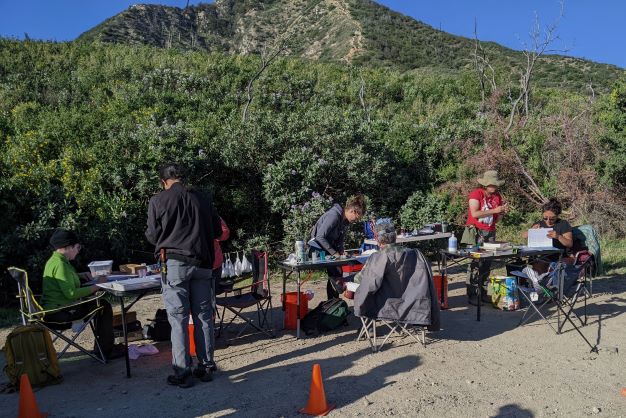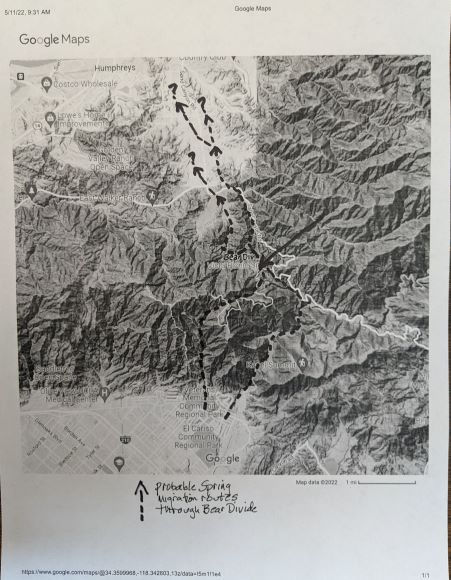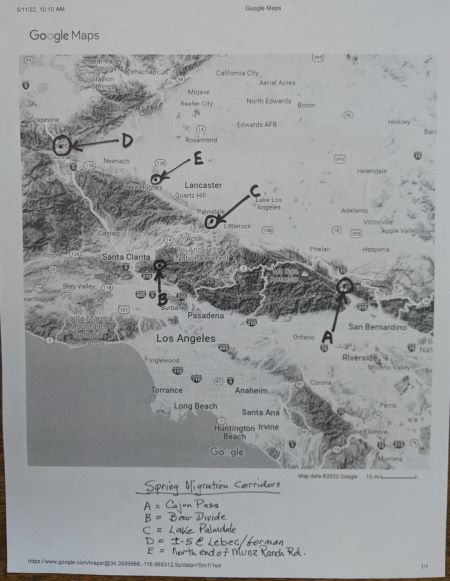
BEAR DIVIDE, Santa Clarita, Los Angeles County CA
Date: April 10, 2022
Weather: Fair; 58 F to 75F; wind W, WNW 5-10 mph.
Time: 0711-0945 hrs.
Observers: Dr. Zia Nisani (Antelope Valley College Biology Dept.), Charles Hood (Antelope Valley College English Dept.) and I; dozens of other birders, including Mark and Janet Scheel, Dr. Ryan Terrill; About 15 Occidental College ornithology students, including several individuals mist-netting, bagging and collecting morphometric data on birds adjacent to the parking area (photo).

Area Covered: Most of us stood at the edge of the parking area and, using binoculars, observed birds migrating roughly northward, up a chaparral-pine-oak canyon and over the ridge, descending into the Santa Clarita Valley. From this vantage point (about 1,680 ft. above sea level), land birds of about 30 species could be seen flying at or just above eye-level, approaching the east-west ridge and into a mild headwind, sometimes alighting on the ground or atop large shrubs and bare branches, before continuing northward (see annotated bird list below). Identification of small species, e.g. warblers and sparrows, was often impossible unless birds alighted in direct view. The highest volume of migrating birds, i.e. nonstop waves of small flocks and parades of individuals, occurred roughly between 0715 and 0815 hrs.. By 0900 hrs. there were periods of several minutes without any migrants crossing the ridge.
Some migratory species, e.g. White-crowned Sparrow, Chipping Sparrow, appeared to congregate in broken chaparral-grassland just below or on the ridge. Resident species, e.g. Mourning Dove, California Scrub-Jay, Wrentit, House Finch, California Towhee, vocalized and moved around the area during our observations.
Discussion
This was my first visit to Bear Divide, I’m somewhat embarrassed to admit, having done hundreds of bird surveys in the area since the early 1980’s. Witnessing the large numbers of migratory birds crossing Bear Divide was phenomenal indeed, and as far as I know, unique in this region (Terrill, R.S. et. al. 2021. Western Birds. 52 (4): 322-39). As a result of this visit, I began to research my field notes for Los Angeles, San Bernardino and Kern County, looking specifically for locations where aggregations of relatively large numbers of migrants in spring and autumn had been seen. A few such places came to mind and are shown below (Figure 2).

Five outstanding locations in the region, east to west, include Cajon Pass (San Bernardino County), Lake Palmdale, Bear Divide, Munz Ranch Rd., and I-5 near Gorman, have consistently had relatively large numbers of migratory land birds during spring (March-May) and autumn months (September-October – Bear Divide?). Except for Bear Divide, I have done multiple bird surveys in all of those locations through the years. But the fact remains, I have found no other location in the region with a high volume of migrants comparable to Bear Divide.
Lacking sufficient data along a broad, south to north axis of spring migration, our knowledge of the migratory routes taken by land birds is fragmentary at best. What seems likely to be occurring, is that birds are moving northward following the historically shortest path of least resistance, highest refueling potential, adequate cover, and perhaps least disturbed by auto traffic, housing developments, outdoor lighting, utility lines and other artificial obstacles. Bear Divide evidently meets most if not all of those criteria (Figure 1).
Similarly, Cajon Pass (elev. 3,776 ft.), which provides a comparatively short-distance gap between the San Bernardino and San Gabriel Mountains, is probably another major migratory corridor. Unlike Bear Divide, however, freeway traffic (I-215 & I-15) is heavy and winds through the Cajon Pass are often fierce. During periods of strong winds, I have found numerous spring and autumn migrants packed together at the south entrance to Cajon Pass in Glen Helen Regional Park and to a significant though lesser extent, along adjacent North Glen Helen Road, bordering hillside chaparral and planted eucalyptus groves (mostly on private property). Northbound from there, following the old US Route 66, the backcountry junction of Swarthout Canyon Rd. and Lone Pine Canyon Rd. probably deserves more attention from ornithologists than currently received. My guess is that there is a secluded location in that area comparable to Bear Divide in terms of the volume of migratory birds.
What route do Spring migrants take after descending from Bear Divide? Looking at a regional map (Figure 2), it appears possible that birds continue in a northeasterly direction paralleling CA-14. If so, then many would reach the pass between Ritter Ridge and the San Gabriel Mountains (“Palmdale Bulge”) bordering the Antelope Valley. That route would place migrants in full view of Lake Palmdale, a prominent fault-zone reservoir (elev. 2,822 ft.) with a bird list of around 260 species. The results of long-term surveys at Lake Palmdale indicate that a wide variety of northbound migrants are attracted there each spring. Of course, the provenance of those birds remains almost completely unknown.
Richard Crossley has recently documented the movement of significant numbers of spring migrants paralleling I-5 in the vicinity of Gorman, presumably headed for Tejon Pass (elev. 4,160 ft.). That is an important piece of the regional migration puzzle. It seems possible that at least some of the birds Mr. Crossley has observed along Gorman Post Rd. had recently passed over Bear Divide and continued flying in a northwesterly direction through Santa Clarita and Castaic. Then, how much of an effect on migration does heavy freeway traffic have in this area? Are birds moving along the foothills paralleling the freeway? Perhaps the I-5 corridor was the ancient migratory route, preempted by continuous, massive movements of automobiles.
I’m fairly certain that most land bird migrants heading northward from Bear Divide avoid the highest mountains (e.g. Jupiter Mt. (elev. 4,498 ft.), Grass Mt. (elev. 4,600 ft.) and busy roadways through narrow canyons (i.e. Bouquet Canyon Rd. and San Francisquito Canyon Rd.). I have lived in this area (Green Valley) since 1987 and would have surely noticed migrants moving through in large numbers. Nada. So, how are most land birds reaching the Antelope Valley, where they are found in abundance each spring in desert oases such as Apollo Park and Piute Ponds?
One possible south-north, migratory corridor along the western San Andreas Fault – Portal Ridge route, is the lightly traveled Munz Ranch Rd., connecting Lake Elizabeth (elev. 3,192 ft.; cottonwoods and chaparral for a rest/refueling stop) with the grasslands and poppy fields of the western Antelope Valley (Figure 2, E). In fact, this shallow canyon does appear to have fairly high numbers of warblers and sparrows during migration (Jonathan Feenstra found a rare Cassin’s Sparrow there in May, 2014). When faced with strong NNE winds, I have found a variety of migrants together, keeping low in roadside vegetation and on fence lines at the junction of Munz Ranch Rd. and Lancaster Rd..
These and other empirical observations suggest that there may be consistent migratory routes for birds moving into and out of the Antelope Valley. Many questions remain unanswered, e.g. is the “Golden Triangle” at the southwest corner of the Antelope Valley (Figure 2, D) more important as a northbound (spring) or southbound (autumn) migration corridor? Clearly, there is plenty of room for further exploration in this region.
BIRDS NOTED – Bear Divide April 10, 2022 Callyn Yorke (species reliably reported by other observers this day at BD, which I did not see, are shown in bold type) 36 Species.
Band-tailed Pigeon 6 pairs flying 20-80 ft. above ground level (agl) around and through the pass; Mourning Dove 4 gregarious on open ground around the USFS fire station; Vaux’s Swift 15 loosely gregarious, migrating 20-50 ft. agl through the pass and above the adjacent peak; White-throated Swift 1 with VASW, ca 100 ft. above adjacent peak; (Rufous ?) Hummingbird 2 (m) individuals migrating at about 15 ft. agl through the pass; Turkey Vulture 2 loosely gregarious flying 50 ft. agl over BD to the SE; Red-shouldered Hawk 1 (reported as a first record for BD by Ryan Terrill); Zone-tailed Hawk 1 (reported as a first record for BD by RT); Red-tailed Hawk 1 (ad) soaring 50-80 ft. agl above adjacent peak; Acorn Woodpecker 1 perched on dead limb near mist nets; Red-breasted Sapsucker 1 (reported by several other observers); Ash-throated Flycatcher 12 loosely gregarious, migrating 7-15 ft. agl, often alighting in tall shrubs, at least two netted, bagged and processed; Cassin’s Kingbird 1 migrating 10 ft. agl through the pass; Western Kingbird 12 individuals and pairs, migrating 10-15 ft. agl through the pass; California Scrub-Jay 1 flying low over chaparral hillside beneath the pass; Northern Raven 2 (one molting secondaries) a pair flying se below the pass; Tree Swallow 30 gregarious, several separate flocks of 2 -5 birds migrating 15 -30 ft. agl through the pass; Violet-green Swallow 6 gregarious, pairs migrating 10-20 ft. agl through the pass; Barn Swallow 1 migrating 10 ft. agl through the pass; Wrentit 1 repeatedly vocal (unseen) in adjacent chaparral hillside; House Finch 2 vocal a pair in and around planted pines at ranger station; Lesser Goldfinch 2 vocal, a pair flying to large pines at ranger station; Orange-crowned Warbler 2 in chaparral on roadcut below pass; Nashville Warbler 1 (m) netted and processed by Occidental ornithology crew; Yellow-rumped (A) Warbler 200 (conserv. est.) loose flocks flying 10-20 ft. agl through pass; Hermit Warbler 1 (m) resting momentarily on emergent shrub near mist nets; California Towhee 2 in chaparral near mist nets; Chipping Sparrow 12 gregarious on ground and in low shrubs in weedy roadside area next to the parking lot; Black-chinned Sparrow 1 vocal in chaparral below the pass; Savannah Sparrow 1 in a Spanish broom shrub next to a roadcut below the pass; White-crowned Sparrow 60 occasionally vocal, gregarious, apparently lingering in chaparral gully below the pass and on hillside adjacent to the mist nets; Black-headed Grosbeak 4 (m,f) migrating at 10 ft. agl over the pass, one netted, bagged and processed; Blue Grosbeak 2 (m) on top of roadcut below the pass; Lazuli Bunting 12 (m) flying 5-10 ft. agl over the pass, at least one male netted, bagged and processed; Bullock’s Oriole 4 (m,f) gregarious, flying 8-10 ft. agl, alighting in tall shrubs at the pass; Great-tailed Grackle ? (reported by an unidentified birder).